

To send a message to an author, click on the author's name at the end of the article.
This Month in Ag Connection | Ag Connection - Other Issues Online
Proper care of trees is important, especially when young. Neglecting or damaging trees can send the tree into decline and cause eventual death. Homeowners might be their trees' worst enemy if they do not take standard precautions.
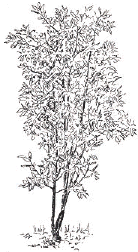
Remove winter wrap from the trunk of trees, as they can cause harm to the tree if left on throughout the summer. Careless mowing and weed trimming can cause damage to the base of the tree which can result in a slow death. Trees do not heal from cuts like humans, so a lawn mower scrape, or a trimmer slash, creates a permanent injury. Once the underlying wood is exposed, trees are more likely to be attacked by disease and insect pests. Many older trees have succumbed to internal rot which originated with damage caused years earlier. There is an easy way to avoid this kind of damage. Prevent grass and weeds from growing around the tree. Not only will it make it unnecessary to mow near the tree, the tree will not have to compete for nutrients and water. Spreading mulch around trees will keep weeds and grass under control and will give the tree base an attractive appearance. Mulch will also help conserve moisture, keep soil temperatures stable, and add nutrients to the soil. Mulch should be placed around a tree in the shape of a donut, not a volcano.
Throughout the growing season monitor trees for insect pests. The Eastern Tent Caterpillar is a native defoliator found feeding on leaves in late spring. Its preferred hosts are wild cherry, apple and crabapple, but it will occasionally feed on forest and ornamental trees such as ash, birch, maple, oak, poplar, cherry and plum. The adult moth looks stout-bodied, is reddish-brown and 0.5 to 0.75 inch long, and has a wingspan of about 1 to 2 inches. During late summer, the adult female will lay 200 to 300 eggs in bands around small twigs on the host tree. The eggs do not hatch until the next spring, about the time the buds of the host tree begin to break open. Upon emerging, the young caterpillars migrate to a nearby fork on the tree and spin a thick web nest or "tent" where they live together. As the larvae grow, the webbed nest is enlarged. During the day, the larvae leave the nest to feed on the foliage. As it leaves the nest, each larva will spin a strand of silk as it travels, perhaps to help find its way back to the nest. The larvae remain in the nest during the night and on cloudy days. The mature larva is about 2 inches long and generally dark in color. It has a dark-colored head and a white stripe running down the center of the back. The body is sparsely covered with fine light brown hairs.
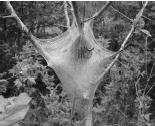
When mature, a larva will leave the nest and search for a protected place where it spins a rather large, thick, white cocoon around itself to pupate. These cocoons can be found on the sides of trees, among debris on the ground, on brush and weeds, fences and even on sides of buildings. There is a single generation each year. Control methods include tearing web nests out of trees and allowing caterpillars to fall to the ground where they can be eaten by natural predators like birds. Chemical spraying is usually not necessary.
For more information, related to potential caterpillar damage refer to MU Extension guide G7271 -Insect Defoliators of Missouri Trees: Web Producers.
Know the common diseases of trees and their symptoms. Some diseases such as anthracnose, tar spot and other types of leaf spots, are aesthetic and do not need to be controlled with chemical sprays. As trees flower this spring be mindful of the bees and other pollinators. Never use pesticides around trees in full bloom.
Additional informational on the care of woody ornamentals can be found in MU Extension Guide MG7-Establishment and Care of Woody Ornamentals.
Source: Jennifer Schutter, Horticulture Specialist
This Month in Ag Connection | Ag Connection - Other Issues Online
Deciding whether to replant a sparse stand is one of the more difficult decisions for a corn or soybean grower. The difficulty of this decision stems from predicting how the effectiveness of replanting will be affected by the combination of planting date and changing environmental conditions.
However difficult, replant decisions are made by at least some Missouri farmers every year.
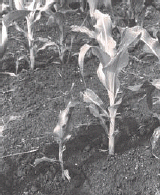
University of Missouri Extension guide G4091 titled Corn and Soybean Replant Decisions provides a step-by-step procedure for estimating dollar gain or loss from replanting. This procedure involves a careful study of the field in question and an analysis of its yield potential. The procedure begins with determining the cause of the sparse stand. Next, information is gathered on the stand density and condition of the stand. This information is used to estimate the yield potential and income from the current stand. Next, the guide provides tips on determining the cost to replant and estimating the yield potential and income from the replanted stand. With this information in hand the original stand income estimate can be compared to the replant stand income estimate to determine the economic benefit from replanting.
The corn and soybean replant decision guide (G4091) is four pages long, and provides a one-page fill-in-the-blank worksheet that can be filled out with information from the field in question. Research based estimates of crop yield based on planting date are provided for use in estimating the replanted stand yield based on planting date. Planting date trials in central and north Missouri provided the data used in the estimates shown in the following table from Guide G4091.
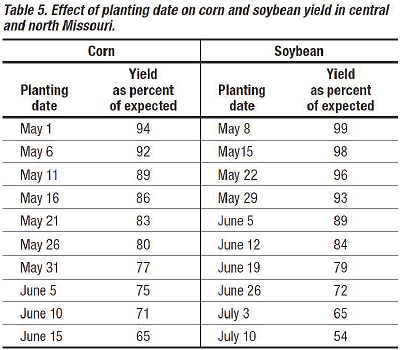
To determine whether replanting is appropriate, compare the net income from replanting with the income from a sparse stand. Even if this comparison is positive, a producer still may not wish to replant. Other demands on time and competing crop management issues are important considerations.
The worksheet provided in guide G4091 can help in organizing the important information and arriving at a well-informed decision. It is followed by an example of a completed worksheet with a note about the probable decision. A Microsoft Excel workbook containing the replant worksheet calculations is available at http://agebb.missouri.edu/download/university/replant.xlsx
Source: Max Glover, Agronomy Specialist
This Month in Ag Connection | Ag Connection - Other Issues Online
Estate planning should be a part of every farm and business owners' operation. Individuals may have different priorities when planning, but common goals typically include:
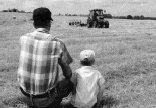
After determining goals, one needs to consider the tools available in achieving estate planning goals. Some of the tools include title, wills, probate, non-probate, trusts, life insurance, and gifts. This article will focus on transfer by title.
In Missouri, title takes precedence over other transfer methods. So if there is a conflict with a title having someone's name on it and the same property being left in a will to someone else, the property would go to the person or entity named on the title. Property can be owned solely or by joint ownership. The forms of joint ownership are state specific and in Missouri include tenants by the entirety, joint tenancy with right of survivorship, and tenants in common.
Tenancy by the entirety is a form of ownership which can only exist between spouses. Each one owns an undivided 100%. If John and Jane Doe own 100 acres, one would not say John has 50 acres and Jane has 50 acres. Property cannot be sold without the consent of both spouses. Creditors cannot go against an entirety's property just to satisfy the debt of one spouse. The surviving spouse remains as the sole owner of the property. This form of ownership is used as a means of avoiding probate, because the ownership change occurs as a matter of law.
The second type of property ownership is joint tenants with right of survivorship (JTROS). JTROS can be between any two or more persons. They all have to own equal shares in the asset. If the ownership interests are not equal, then it is presumed to be tenants-in-common property. When a joint tenant dies, the interest automatically passes to and is divided between the surviving tenants. The last person surviving automatically gets 100% of the property.
Tenants in common is the third type of co-ownership. Two or more people own an undivided interest in the property without having to have equal shares. Each owner can determine who inherits their share. This is a great tool for large estates or for people who re-marry and have kids from previous relationships that they want to transfer property to.
Once one becomes the sole owner of property reconsidering the options to transfer property may be important. For example, the sole remaining owner dies without a beneficiary deed, and the property has not been re-titled to a trust, then the property would pass through probate. If a will names who gets the property, it will still pass through probate. Title is the simple way to transfer property, but as with most estates, it should be combined with other transfer tools to address more of your estate planning goals.
For further information on estate planning, contact your local University of Missouri Ag Business Specialist.
Source: Darla Campbell, Ag Business Specialist
This Month in Ag Connection | Ag Connection - Other Issues Online
The 44th Annual Northeast MO Performance Tested Bull Sale was held at Palmyra on March 26. The overall average on forty bulls was $4,379.
The high breed average was Polled Hereford at $4,875. Other breed averages were Simmental $4,700, Angus $4,324, and Charolais $4,300.

High selling bulls in the sale were Angus consigned by Kris & Tracy Graupman, Palmyra and Shannon Farms, Bowling Green and sold for $6,000 and $5,900 respectively. They were purchased by Wallace Metz, Fulton and Ed Jackson, Frankford. Thirteen other bulls sold for $5,000 or higher.
Other top selling bulls included M.B.S. Charolais, top Charolais at $5,800; Donald Drebes, top Simmental at $5,300; Keithley/Jackson, top Hereford at $5,000.
In order to be eligible for this sale, bulls needed to be in the upper 50th percentile in two out of four EPD (Expected Progeny Difference) traits: (CE or BW), WW, YW, or Milk. Additional requirements included: yearling height at a minimum of 49 inches, weight at a year of at least 1100 pounds, semen tested, examined for breeding soundness, and be a satisfactory potential breeder. Health requirements included: tested negative for Brucellosis and BVD-PI, vaccinated against Leptospirosis, and follow state requirements for trichomoniasis.
Following the bull sale, the annual meeting of the Northeast Missouri Beef Cattle Improvement Association, which sponsors the sale, was held in Hannibal with several awards presented. Plaques were presented to the owners of the high indexing bulls in the sale. Simmental went to Donald Drebes, Charolais went to M.B.S. Charolais, Angus went to Shannon Farms, and Hereford went to Keithley/Jackson. Other awards included: Outstanding Seedstock Producer, David Linnenburger, Canton; Outstanding Commercial Producer, Gene and Kim Dryden, Hannibal; and Outstanding Service to Brian Curless, Pittsfield, IL.
The sale is a cooperative effort between the Northeast Missouri Beef Cattle Improvement Association and University of Missouri Extension. For details on participating, contact your local University of Missouri Extension Livestock Specialist. The next sale will be March 25, 2017 at F & T Livestock Market, Palmyra.
Source: Daniel Mallory, Livestock Specialist
Publishing Information
Ag Connection is published monthly for Northeast and Central areas of Missouri producers and is supported by the University of Missouri Extension, the Missouri Agricultural Experiment Station, and the MU College of Agriculture, Food and Natural Resources. Managing Editor: Mary Sobba.